— By Kara Lynn Dunn, Great Lakes Publicist, New York Sea Grant
Contact:
Kathy Bunting-Howarth, NYSG's Associate Director, E: keb264@cornell.edu, P: 607-255-2832
Ithaca, NY, November 4, 2024 - New York Sea Grant (NYSG) fellowships in 2024 provided nine students with diverse learning experiences working with scientists, students, community groups, and legal issues. Here is a summary of the opportunities made possible through NYSG’s New York Coastal Resilience Law and Policy Fellowship, Community Engaged Internship, and Cornell Cooperative Extension Summer Internship programs.
Community Engaged Internship Fellows
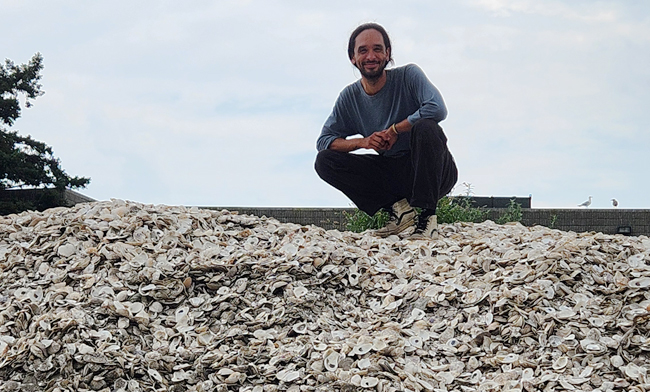
CEI Fellow Zachary Strein visited the Billion Oyster Project that is restoring reefs to New York Harbor through public education initiatives in New York City.
Exploring Aquaculture Extension
Zachary Tan Strein is a third-year Earth and Environmental Science student at Brooklyn College. As 2024 Community Engaged Internship Fellow (CEF), Zachary worked closely with New York Sea Grant (NYSG) and Cornell Cooperative Extension specialists on a variety of aquaculture projects.
“Through this experience, I have gained insight into the roles that Extension professionals play in the marine sciences and the complex web of connections that constitute our living environment,” Zachary said.
Zachary assisted Suffolk County Marine Education and Learning Center hatchery staff with day-to-day operations, including oyster larvae production and deployment. As part of the team in Dr. Bassem Allam’s lab at Stony Brook University, Zachary spent time on the water of Eastern Long Island in support of bay scallop research. He participated in hard clam spawning as part of the Hard Clam Selective Breeding project and attended Marine Camp for youth at Jones Beach.
“On Long Island, Extension professionals support the public, researchers, private industry, and the wider ecosystem. Extension is not work done in isolation. I enjoyed working with Extension, Sea Grant, Stony Brook University, and many not-for-profits that are working on shellfish restoration for Long Island towns. It takes partnerships and a great deal of resource-sharing to do the work,” Zachary noted.
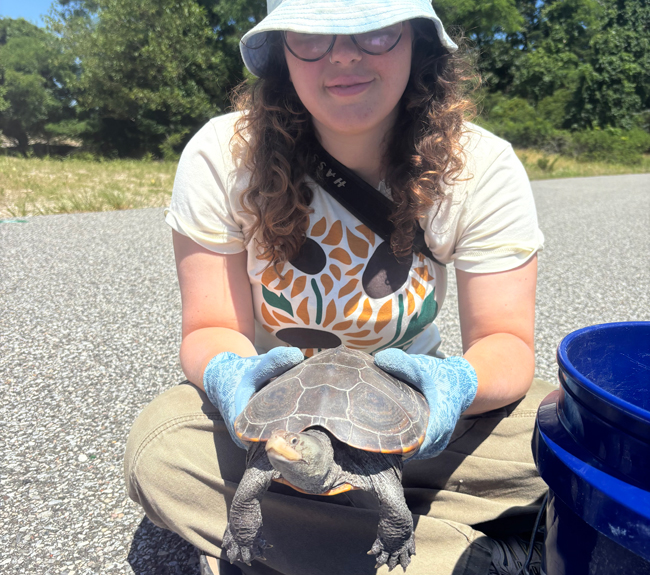
Shanee Krichley assisted terrapin research and restoration with the Friends of Flax Pond’s diamondback terrapin monitoring program.
Helping Diamondback Turtles on Flax Pond
University of Rochester student Shanee Krichely worked with the Friends of Flax Pond’s diamondback turtle monitoring volunteer program that is working to restore the protected native turtle species in New York. Shanee worked alongside community members, from high school students to seniors, and people of diverse experiences.
“My biggest benefit was being able to work hands-on with the terrapins and analyzing the data. The data analysis experience was impactful, informative, and useful as I realize now how challenging working with a large dataset is and I have learned how to handle and process such large pieces of information,” Shanee says.
Shanee created social media/blog content related to the field research and developed skills for effectively communicating the science to the public using multiple different media tools.
Shanee also assisted a New York Sea Grant program that provided beach visitors with the opportunity to try seining and to test water quality.
“This experience has given me so many skills and a real sense of what environmental work could look like. For anyone looking for a first experience working a job in the environmental field, this Fellowship program is the perfect chance to try working on many things as well as the opportunity to talk to many people who have such niche jobs,” Shanee says.
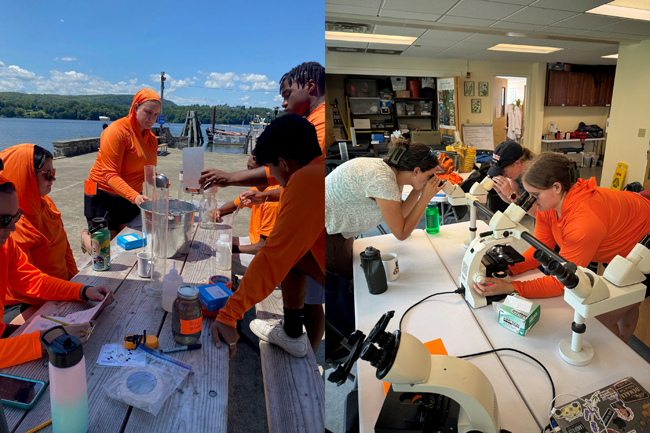
Maya Moffit conducted field and lab work in support of TEAM SCRAP at Norrie Point’s National Estuarine Research Reserve.
Microplastics Research in NY’s Hudson River Region
Maya Moffitt, a rising junior at the SUNY College of Environmental Science and Forestry, assisted New York State Water Research Institute (Cornell University) programming centered on community education about microplastics and marine debris collection. Maya’s experience included time in the field and laboratory at the Hudson River National Estuarine Research Reserve at Norrie Point.
“The local issue was the presence, but unknown concentration, of microplastics in the Hudson River. I worked with members of The Education And Microplastics Science Community River Assessment Project (TEAM SCRAP) on sampling along the Hudson River and some of its tributaries to develop a comprehensive collection of data from past and present years,” Maya explains.
Maya helped create an outreach flier and a report of TEAM SCRAP findings since 2021, and engaged local students about microplastic pollution through small school programs and The Institute Discovering Environmental Scientists (TIDES).
“This fellowship experience allowed me to explore different aspects of science, work alongside so many wonderful people, and taught me how to form research from start to end. I had a very supportive mentor who allowed me to make the final report my own. I also greatly benefited from getting to be in an environment that was filled with others who are just as passionate about this type of research and education as I am,” Maya said.
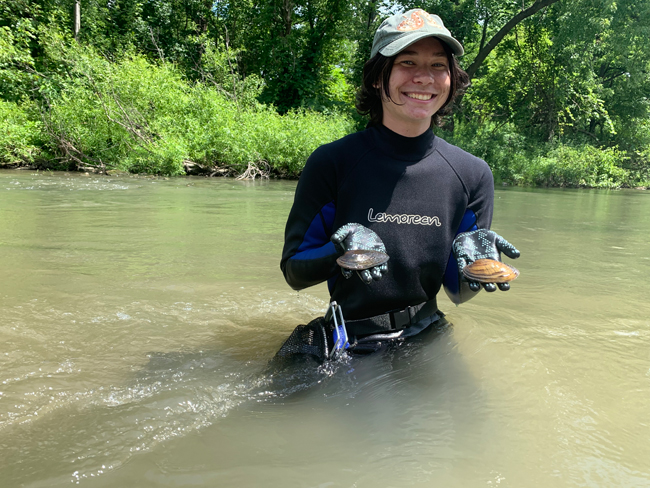
Fen Stanczyk studied freshwater mussels in Great Lakes tributaries alongside researchers from the University at Buffalo.
“Mussels” Experience Builds Confidence
Fen Stanczyk, a rising senior in Environmental Studies at the University at Buffalo (UB), participated in freshwater mussel and aquatic ecology research with a team of researchers, professors, graduate students, and undergraduate students at UB. Fen was part of virtual weekly meetings with Sea Grant and National Oceanic and Atmospheric Administration staff from around the country.
Through this summer experience, Fen helped with several surveys identifying, counting, and measuring where mussels are found in Western New York streams and their age distribution, and comparing their current population to historic survey data. Seine net surveys of small fish, processing samples, and macroinvertebrate surveys and lab identification were also completed. To extend this research to the general public, Fen created informational brochures aimed at anglers and for shoreline property owners, and an ArcGIS StoryMap.
“The opportunity to be a part of an academic research setting for the first time helped build my confidence in this environment, and helped clarify my future academic and career goals. I look forward to applying everything I’ve learned this summer to my future endeavors,” Fen added.
Fen was one of 20 students selected to spend a week in North Carolina visiting ecologically-unique sites, hearing a range of speakers, and meeting others Community Engaged Fellows based around the United States.
“The time in North Carolina was a great opportunity to hear many different perspectives and to discuss how the environmental and social issues of each of our areas were similar and different. Sharing everyone’s fellowship projects demonstrated the range of topics and tasks that are all interconnected under environmentalism,” Fen said.
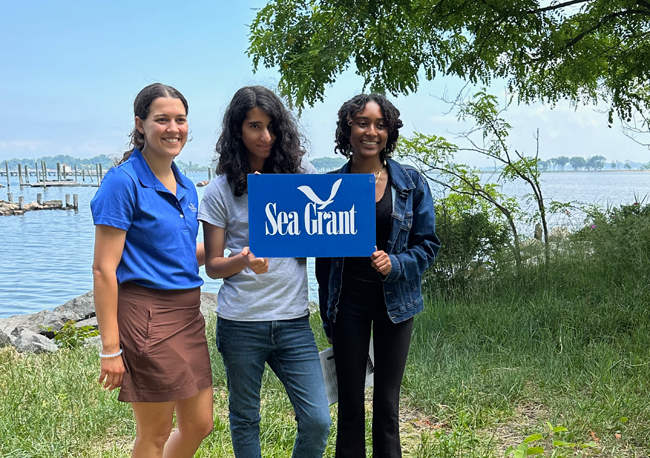
Victoria Charles conducted Natural and Nature-Based Features Monitoring along the Bronx River and Long Island Sound, collecting data to inform about the health and benefit of marsh and wetlands along the Bronx River and Long Island.
Experiences Enhance Multiple Skill Sets
Queens College student Victoria Charles spent her summer working with school students, educators, and researchers in New York City’s urban-natural environments. Victoria conducted water quality tests with 4th-grade students from New York’s PS 583. Through a program with the New York City Department of Environmental Protection, Victoria assisted with the organizing of professional learning programs and water quality workshops for educators throughout New York City.
Time as an Ecological Assessment Field Assistant with a partnership program of NYSG, the Long Island Sound Study, and Natural Areas Conservancy in New York City offered Victoria a focus on the conservation and management of natural areas along the Bronx River and Long Island Sound, working alongside experienced ecologists to collect and analyze field data.
Through NYSG’s Natural and Nature-Based Features project, Victoria says, “I learned how to survey the slope of shorelines on Randall’s Island and focused on salt marshes located on the Long Island Sound. This project involves conducting plant identification using a quadrat (a frame to mark or grid a study area), performing data analysis with ArcGIS and R2 unit, and contributing to the Long Island Sound Study’s restoration efforts. The data collected is reported to the Department of State, ensuring that our findings support state-level decision-making and policy development, helping local communities protect their coastlines and promoting environmental justice.”
Victoria notes that the CEF experience provided opportunities to develop skills related to public speaking, environmental education and advocacy, data analysis, ArcGIS products, and habitat restoration.
“These experiences have not only enhanced my ecological research skills, but also prepared me for a future career in environmental conservation and law,” Victoria concludes.
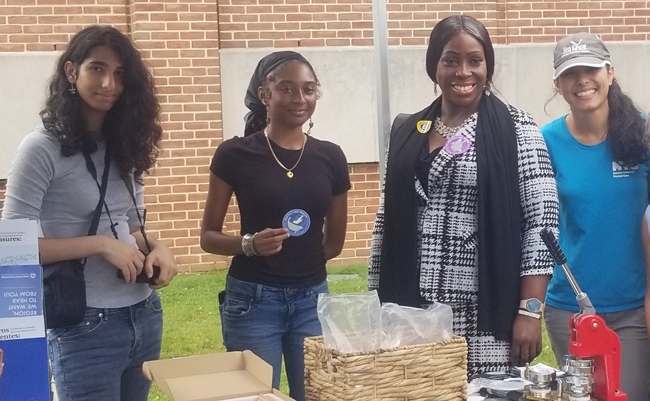
Crow Idnani helped guide more than 100 Eco-Ambassador teens from around the globe on a microplastic pollution summer course, a collaborative project with Columbia University’s Lamont-Doherty Earth Observatory.
Crow Idnani, a junior at Cornell University, assisted with the Columbia University Earth Institute’s summer 2024 Eco-Ambassadors program. The program engaged approximately 120 high school students from 15 countries with activities focused on microplastic pollution and mapping software. Crow’s tasks included managing Zoom meetings and a Google classroom page, coordinating guest speakers, giving a number of presentations, and handling student emails about the program.
“By the end of the program, the students created an ArcGIS story map about a local issue that they can present to local policymakers,” Crow explains.
Crow also worked with a New York Sea Grant Long Island Sound Study specialist on in-person events for students from local communities to raise their awareness of and encourage stewardship of the Long Island Sound environment.
“Working with people from diverse backgrounds and disciplines and being able to see how all the distinct pieces of environmental outreach fit together gave me a better sense of where I want to take my career after graduation. There were ample networking opportunities provided by New York Sea Grant that were also helpful,” Crow says.

James Hoehner deploys a zooplankton net from aboard the EPA Research Vessel Lake Guardian conducting CSMI research on Lake Erie in 2024.
CCE Internship Supports Science Communication
Cornell University junior James Hoehner participated in aquatic research on Oneida Lake and on Lake Erie through a 2024 Cornell Cooperative Extension (CCE) Internship experiences facilitated by the Cornell Biological Field Station on Oneida Lake (CBFS), CCE Madison County, and NYSG.
On Oneida Lake, James participated in on-water “field” work with the opportunity to see a wide variety of organisms including fish, birds, and invertebrates. His experiences during a week aboard the Environmental Protection Agency Research Vessel (R/V) Lake Guardian on Lake Erie, James helped with zooplankton netting, tucker trawling for larval fish, and PONAR grab sampling for mussels and benthic invertebrates, working alongside CBFS personnel, as part of the 2024 bi-national Cooperative Science and Monitoring Initiative for the Great Lakes.
“Getting out on the water helped with creating extension materials because I got to hear directly from scientists about the research they are working on and experience it firsthand,” James said.
James developed social media posts, a weekly blog, and an ArcGIS Story Map that highlights ten projects by conducted by other CBFS summer interns. He also developed outreach exhibits and events, including a booth at the Madison County Fair and games and activities for an aquatic ecology youth open house at CBFS.
“Getting out on the water helped with creating extension materials because I got to hear directly from scientists about the research they are working on and experience it firsthand,” James said. “The collaborative nature of my project greatly developed my skills in both research and extension, which has allowed me to grow as a scientist. I have learned that extension is important to scientists as well as members of the public, and that both parties can learn from each other. I will be sure to emphasize extension efforts in future research I do.”
NYSG Mentors New York Coastal Resilience Law and Policy Fellows
The New York Coastal Resilience Law and Policy Fellows program is a collaborative program of New York Sea Grant, a cooperative program of Cornell University and the State University of New York; University at Buffalo School of Law; the City University of New York Law School; and the Elizabeth Haub School of Law at Pace University. This fellowship was established with two Legal Capacity Building grants from the National Sea Grant Law Center. The students selected for these fellowships, which began in 2020, work with New York Sea Grant Extension specialists on projects specific to local community needs.
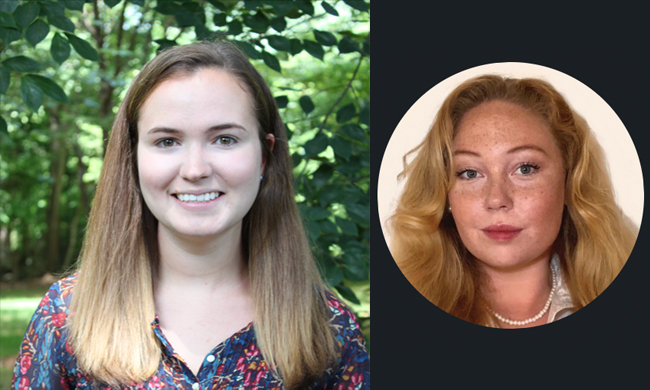
(At left) Stephanie Sistare Hill; (At right) Sophie Bacas
Researching Microfiber Filtration Legislation
Stephanie Sistare Hill is a 2nd-year Juris Doctorate candidate at the City University of New York (CUNY) School of Law with an interest in environmental law. Stephanie created a case study of California Assembly Bill 1628 which would “require all new washing machines sold in California for residential or state use to contain a microfiber filtration systems by January 1, 2029, and allows the Attorney General or local prosecutors to assess civil penalties for a violation of this requirement,” according to a letter from the Office of the Governor of California posted on gov.cas.gov. That letter returned the bill to the California State Assembly without the Governor’s signature on October 8, 2023.
On July 31, 2024, U.S. Senate Bill S. 4844, dubbed the “Fighting Fibers Act of 2024,” was presented for consideration “to require that all new washing machines sold or offered for sale in the United States contain a microfiber filtration system, and for other purposes.” The bill was referred to the Committee on Commerce, Science and Transportation.
Stephanie’s project included a literature review of current microplastic legislation globally and nationally. She developed an informational fact sheet to inform audiences about how the proposed microfiber legislation in California was received, the issues touted as the pros, and issues raised as concerns.
“The New York Sea Grant Law and Policy Fellowship provided me with the opportunity to learn more about water quality policy after receiving my Masters in Public Health in community health education. I would highly recommend this fellowship to any law students who would like to learn more about environmental law and policy and engage with communities,” Stephanie says.
Helping Citizens Understand Local Environmental Laws and Codes
Sophie Bacas is a 2nd-year Juris Doctorate candidate at the Elizabeth Haub School of Law at Pace University. She holds undergraduate degrees in Marine Affairs and Environmental Law and Natural Resources Economics form the University of Rhode Island. As a New York Coastal Resilience Law and Policy Fellow, Sophie prepared two informational documents addressing legal means of protecting local environments.
To help citizens better understand the process for voicing concerns to prompt local government to create a local laws related to those concerns, Sophie conducted extensive research and wrote a Local Law Adoption Summary Report. The report describes municipal home rule laws, their relationship to environmental concerns, and how a local law is developed and adopted.
Additionally, Sophie wrote a Peconic Estuary Shoreline Municipal Codes Assessment of use to citizens and municipal leaders in the Long Island communities of Brookhaven, East Hampton, Riverhead, Shelter Island, Southampton and Southold. Sophie notes that as climate events raise the potential of costly damage to local infrastructure and economies, townships can consider amendments to their local codes regarding such issues as building and permitting processes and to increase the resiliency of their coastal areas. The document offers a detailed look at the municipal codes in each of the six towns. Strengths in the codes include outlining the benefits of local environmental resources in a code’s “Findings” section, noting “Ecologically Sensitive Areas,” instructions on how to properly apply for a permit, and how closely the codes align with the New York Department of State Model Local Laws.
“This experience was a wonderful opportunity to become educated about shoreline policy and climate change at the local level, and gave me a real-world opportunity to help people in my area,” Sophie said.
Thank You, 2024 Fellowship Mentors
Among the many environmental professionals who shepherded these students through their summer 2024 Community Engaged Internships Fellows (CEF) were New York Sea Grant specialists Antoinette Clemetson (Marine Fisheries), Nate Drag (Great Lakes Literacy), Stacy Furgal (Great Lakes Fisheries and Ecosystem Health), Lillit Genovesi (Long Island Sound Study), Jessica Kuonen (Hudson River Estuary), and Jimena Perez-Viscasillas (Long Island Sound Study). Stacy also mentored CCE Intern James Hoehner in collaboration with CBFS staff: Associate Director Dr. James Watkins, Senior Research Associate Zoe Almeida, and Administrative Assistant Michelle Holeck; and Madison County CCE 4-H Team Leader Tess Southern.
CEF student Zachary Strein offers a special thank you to Suffolk County Marine Education and Learning Center Site Director Gregg Rivara, who is retiring after a 37-year career in Extension. Zachary interviewed Gregg about the diverse projects that Gregg has been involved with over the years and learned about his role as an aquaculture specialist.
Maya Moffitt was co-mentored by Hudson River Estuary Educator Maija Niemistö of the New York State Water Research Institute at Cornell University.
NYSG Associate Director and Cornell University Cooperative Extension Assistant Director Katherine Bunting-Howarth, Ph.D., J.D., and NYSG specialists Kathleen Fallon, Ph.D. (Coastal Processes and Hazards), and Catherine Prunella (Water Quality) mentored the 2024 New York Coastal Resilience Law and Policy Fellows. Dr. Bunting-Howarth, who holds a Juris Doctorate, coordinates the program for all the participating universities.
Thank You, Fellowship Funders
The U.S. Department of Commerce’s National Oceanic and Atmospheric Administration provided funding for seven of the nine fellowships. Fen Stanczyk’s fellowship was funded through the National Sea Grant Office funded Fen Stanczyk’s summer fellowship. Cornell University’s College of Agriculture and Life Sciences and Cornell Cooperative Extension provided funding for James Hoehner’s fellowship.
More Info: New York Sea Grant
Established in 1966, the National Oceanic and Atmospheric Administration (NOAA)’s National Sea Grant College Program promotes the informed stewardship of coastal resources in 34 joint federal/state university-based programs in every U.S. coastal state (marine and Great Lakes) and Puerto Rico. The Sea Grant model has also inspired similar projects in the Pacific region, Korea and Indonesia.
Since 1971, New York Sea Grant (NYSG) has represented a statewide network of integrated research, education and extension services promoting coastal community economic vitality, environmental sustainability and citizen awareness and understanding about the State’s marine and Great Lakes resources.
NYSG historically leverages on average a 3 to 6-fold return on each invested federal dollar, annually. We benefit from this, as these resources are invested in Sea Grant staff and their work in communities right here in New York.
Through NYSG’s efforts, the combined talents of university scientists and extension specialists help develop and transfer science-based information to many coastal user groups—businesses and industries, federal, state and local government decision-makers and agency managers, educators, the media and the interested public.
New York Sea Grant, one of the largest of the state Sea Grant programs, is a cooperative program of the State University of New York (SUNY) and Cornell University. The program maintains Great Lakes offices at Cornell University, SUNY Buffalo, Rochester Institute of Technology, SUNY Oswego, the Wayne County Cooperative Extension office in Newark, and in Watertown. In the State's marine waters, NYSG has offices at Stony Brook University and with Cornell Cooperative Extension of Nassau County on Long Island, in Queens, at Brooklyn College, with Cornell Cooperative Extension in NYC, in Bronx, with Cornell Cooperative Extension of Ulster County in Kingston, and with Cornell Cooperative Extension of Westchester County in Elmsford.
For updates on Sea Grant activities: www.nyseagrant.org, follow us on social media (Facebook, Twitter/X, Instagram, Bluesky, LinkedIn, and YouTube). NYSG offers a free e-list sign up via www.nyseagrant.org/nycoastlines for its flagship publication, NY Coastlines/Currents, which it publishes 2-3 times a year.